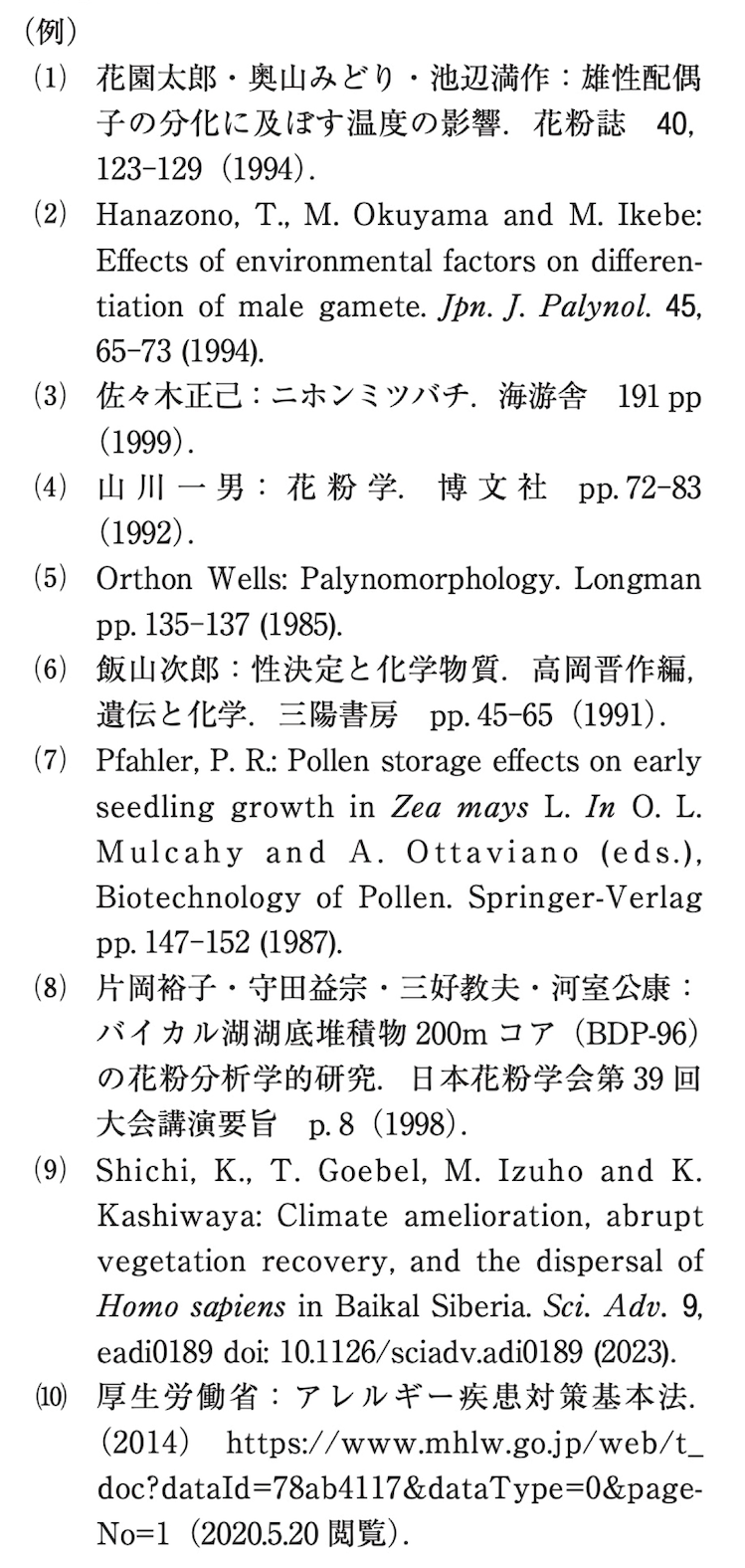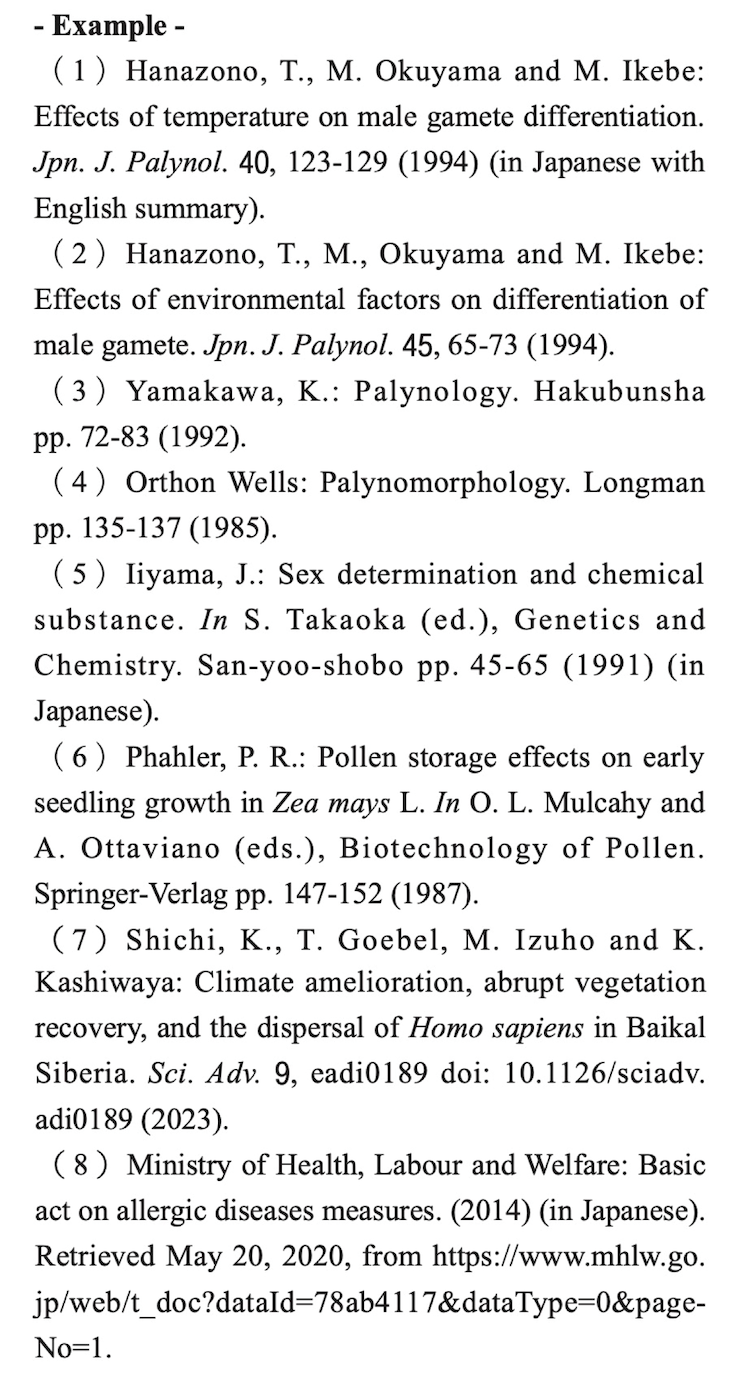-
会誌には,会員(会員以外の共著者を含んでもよい)からの投稿による花粉や胞子に関する原著論文,短報,学術資料,総説.解説などを掲載する.
-
原 著論文,短報は未発表の研究論文とする.学術資料は各分野における貴重な観察結果,技術の紹介および学術研究上の資料となるものとする.総説・解説は,特定の問題に関する最近の知見や研究動向について,関連する文献とともに総括的に議論・解説したものとする.総説は著者の観点を明確化し,解説は他分野の会員にも理解しやすく記述すること.このほか,学会や会誌に対する提案,花粉や胞子に関する話題,人物や著書の紹介などの記事を掲載する.
-
投稿にあたっては,「投稿規程の細則」,最近号の掲載形式に従って原稿を作成する.細則に従わない原稿は受付けないことがある.
-
原著論文および短報は,編集委員長の依頼した2名の査読者によって審査を受けるが,その他の原稿を含めて最終的な採否は編集委員長が決定する.編集委員長は原稿について加除修正を求めることがある.
-
原稿の掲載が編集委員長によって承認された日をもって受理の日とする.原稿の掲載は原則として受理順とするが,編集の都合上前後することがある.
-
原著論文の長さは刷り上がり 12 ページ以内とする.ただし,分野,内容により編集委員会の決定により 16 ページまで認めることができる.短報および学術資料は 8 ページ以内,その他の記事は 4 ページ以内とする.また,総説は 12 ページ以内,解説は原則として 8 ページ以内とする.
-
指定のページ数を越える部分の掲載料金,その他掲載に要した料金(カラー製版印刷費など)は,著者の負担(郵送料を含む)とする.著者負担金の詳細については細則第 8 項に規定したとおりとする.
-
本誌に掲載された論文等の著作権は,日本花粉学会に帰属する.図表等の転載は学会の許可を受けることが必要である.
- 投稿論文の研究について,他者との利害関係の有無を記載した利益相反(conflict of interest)に関する自己申告書を提出する.
-
本規程の改定は編集委員会の議を経て,評議員会の承認を得て行うものとする.
- 原稿は以下の項目とする.
1)表紙 2)本文 3)表
4)図 5)図表の説明 6)利益相反にかかる自己申告書*
(*花粉学会ホームページより様式をダウンロードして記入)
- 表紙には以下の事項を番号順に記載する.
1)発送年月日 2)論文等の種別
3)表題,氏名,所属,住所を和文と英文で併記
4)欄外見出し(3を参照)
5)本文の枚数 6)表の枚数
7)図の枚数 8)図表説明の枚数
9)校正送付先(責任著者の氏名,住所および電話・ファックス番号,電子メールアドレスを明記する)
- 表題は内容を具体的にかつ簡潔に表現したものとする.また,欄外見出しは和文15 字,英文35 字以内とする.
- 本文の書き方
1)和文の場合,原著論文は原則として,英文要約,緒言,方法,結果,考察,和文要約,(謝辞),引用文献の順に項目を設けて記載するものとする.短報には項目を設ける必要はないが,英文要約と引用文献は必ず記載する.英文の場合,いずれの原稿も和文の表題と要約を引用文献の次に記載すること.英文要約は 250 語以内とし,要約の後に改行して 5 語以内のキーワードをつける.その他の原稿はとくにスタイルを指定しない.
2)原稿は A4 横書き,1 ページ 30 行前後とする(刷り上がり 1 ページの目安:24 文字 15 行/枚× 6 枚).原稿の左右,上下には充分な余白(約 3 cm)を設ける.
3)普通に用いられている外国語の術語,物質名はできるだけカタカナ書きとする.
4)生物の学名はイタリックの指定をする.
5)数字はすべてアラビア数字を用い,数量の単位はなるべく SI 法による.
6)引用した文献は引用箇所の右肩に両カッコをつけて,引用順に番号を記す.また,以下の例にならい,引用文献欄で列記する.ただし,総説の場合は本文中に第1著者名と年号(カッコ内)を記し,引用文献欄での配列はアルファベット順にしてもよい.

- 英文については,科学英語のわかる,英語を日常語とする人
の校閲を受けていることを原則とする.
- 図表等の書き方
1)図表は原則として 1 ページに 1 つずつ記載し,それぞれの欄外に必ず,著者名と図表の番号(表 1,図 1 など)を記入する.
2)図表の挿入位置は本文の欄外に朱書きして指示する.
3)著者の原図はそのまま製版できるように,鮮明に描く.図表には希望する縮尺を明示すること.
4)図表の説明は和文または英文(英文がのぞましい)とし,別紙にまとめる.図表の説明は本文を参照しなくてもわかる程度に簡潔に記載する.
- 原稿の送付
投稿原稿は原則として,A4版の用紙に出力可能な電子ファイルを,学会誌編集事務局宛に,電子メール(原則として 10MB 以内)で送付する.表紙と本文は MS Word あるいは PDF ファイルで,図は PDF,JPG あるいは TIFF ファイルで,表は PDF,MSWord あるいは Excel ファイルで送付することが望ましい.ただし,投稿時の図ファイルの解像度は 300dpi 以下とする.受理後,印刷用に投稿時よりも解像度のよい図ファイル(600dpi 以上)を送付する.
電子メールでの投稿が困難な場合(大容量ファイルを送付する場合も含む)は,原稿を保存した電子記録媒体あるいは紙媒体の原稿も認めるが,投稿方法の詳細について編集事務局に予め確認しておくこと.
- 著者負担金
1)制限ページ内の掲載料金は無料とする.
2)制限ページを越える場合は,超過 1 ページごとに 5,000 円の掲載料金を徴収する.
3)別刷りの必要部数と表紙の有無について,初校時に,編集委員長へ連絡すること.印刷業者から著者へ納入された別刷りの経費および送料の支払い手続きは,著者と印刷業者間で行うこと.
4)原著論文,短報,学術資料,総説および解説を除く記事については,原則として別刷りは作成しない.著者の希望により作成した場合,原著論文等に準じ別刷り料金を徴収する.
5)図をカラー製版印刷した場合,経費は著者負担とする.
6)編集事務局から専門家に英文校閲を依頼した場合,経費は著者負担とする.
- 一般公開
会誌に掲載された原稿は学会誌刊行から約1年後にJ-STAGEにおいて一般公開される.なお,著者が希望し、編集委員会が認める場合には,J-STAGEでの即時一般公開する.
- その他
1)印刷原稿や記録メディアで投稿する場合,郵送あるいは宅配便等で編集事務局に送付する.
2)編集委員長は著者から原稿を受取ったとき,受取日を付して受取証を送付する.
3)編集委員長は投稿論文の掲載を承認したとき,著者に受理通知書を送付する.
4)著者校正は初校のみとする.校正に際してミスプリント以外の訂正や変更は許されない.
5)図表等の転載にあたっては,本誌綴込みの転載許可申請書に必要事項を記入の上,編集事務局に送付する.
- 細則の改定は編集委員会の承認を得て行うものとする.
1.Japanese Journal of Palynology is a refereed research journal in all aspects of palynology, a discipline dealing with pollen and spores. The Journal publishes Research Article, Short Communication, Scientific data, Review, and Commentary, submitted by the members of the Palynological Society of Japan. Nonmembers, however, can co-author the manuscripts with at least one member of the Society.
2.Research Article and Short Communication report results of completed studies that are previously unpublished elsewhere. Scientific data include technological advances, observational findings and research data new and noteworthy to palynologists in general. Review and Commentary provide comprehensive discussions or synthesis of a specific subject in palynology with references. Review should reflect clearly the authors’ own views on the subjects and topics covered in the article. Commentary
should be referred to the subject so that members from other
disciplines in palynology would understand it easily. Book reviews,
portraits of researchers, and other information appropriate for the
Journal will be considered for publication.
3.Before submission, authors should consult “Preparation of
Manuscripts,” published in the most recent issue of the Journal.
Manuscripts, which do not follow the instructions, may be returned to
authors without review.
4.Manuscripts submitted for Research Article and Short Communication
will be sent to two reviewers, selected by the Editor-in-Chief, for
evaluation and recommendation on the suitability for publication. The
Editor-in-Chief is responsible for reviewing manuscripts submitted for Scientific data, Review, and Commentary.
The final decision on acceptance or rejection of all the manuscripts is
made by the Editor-in-Chief. The Editor-in-Chief may ask authors extra
revisions of the manuscripts, in addition to the reviewers’ comments
and suggestions.
5.Date of acceptance is the date the Editor-in-Chief gives the final decision of acceptance for publication.
6.Normally Research Articles
should not exceed 12 printed pages. However, in exceptional cases,
where the subject matter necessarily requires additional space, 16
printed pages may be allowed at the discretion of the Editorial
Committee. Short Communications and Scientific data 8 printed pages, and other miscellaneous articles 4 printed pages. Review and Commentary are, in principle, not exceeding 12 and 8 printed pages, respectively.
7.Authors cover all costs necessary for publication, such as extra
pages and color figures, including shipping fee. Page charges and other
miscellaneous costs are described in the section 8 of “Preparation of
Manuscripts.”
8.Manuscripts and editorial communications should be submitted directly
to the Editor-in-Chief of the Japanese Journal of Palynology.
9.Copyrights of all the materials of Japanese Journal of Palynology
belong to the Palynological Society of Japan. No part of the material
may be reproduced in any form or medium without the written permission
of the Society.
10.The corresponding author is required to confirm whether all
authors have any conflicts of interest to declare, and to send the
Conflict of Interest Disclosure Form.
1.Manuscript organization - An article written in English should be arranged in the following order: 1) Title Page, 2) Text, 3) Figures, 4) Tables, 5) Captions for Figures and Tables, and 6) Conflict of Interest (COI) Disclosure Form*.
(*Download the COI Disclosure form from the PSJ Homepage.)
2.Title Page - The title page should contain the following: 1) submission date, 2) type of manuscript(Research Article, Short Communication, Scientific data, Review, Commentary, or others), 3) title, name(s) of author(s), and affiliation and address of each author, 4) running title of the paper (see the Section 3 below), 5) total pages for the text, 6) total number of figures, 7) total number of tables, 8) total pages for Captions for Figures and Tables, and 9) address for a galley proof (mailing address, fax number, and e-mail address of the corresponding author). These items have to be numbered as such in the Title Page.
3.The title should be informative and concise, and tell what the
article is all about. Running title should not exceed 35 letters.
4.Text - For preparation of the text should the following be considered:
1)Research Article should include sections in the following order; abstract (250 words at maximum), key words (five at maximum), introduction, method, results, discussion, conclusion, (acknowledgment), and literature cited. Short Communication, although not all these sections necessary, should contain abstract, key words, and literature cited. Other articles are free in organization.
2)All parts of the manuscript should be typewritten around 30 lines a page with ca. 3-cm margins.
3)Scientific names of the species should be underlined.
4)Numbers should be Arabic numerals, and use of metric unit and SI unit is preferred.
5)References should be numbered sequentially and marked as they appear
in the text. Reference numbers with parentheses should be expressed as
superscripts. All publications cited in the text should be presented in
a list of references following the text, as examples shown below. Review,
however, may cite the name of the first author and publication year of
the paper in parentheses in the text and list the publications in
alphabetical order.

5.In principle, articles written in English should be checked by native
speakers, who also be scientifically literate, before submission.
6.Figures and Tables:
1)Each figure and table should be
presented on a separate page, and must be identified by the authors’
names with the figure number and table number (e.g. Fig. 1 and Table 1)
at the margins.
2)Authors must specify the locations in the text with red letters at
the margins, where individual figure(s) and table(s) are inserted.
3)In principle, original illustrations submitted by authors are used
for publication; therefore those should be clearly drawn and reproduced
in the form of high resolution digital images. Reduction rate for each
figure and picture should be specified.
4)Concise and clear description of the figures and tables, which is
self-explanatory without referring the text, should be written in the
section for Captions for Figures and Tables.
7.Manuscript submission:
In principle, manuscripts(10MB at maximum)should be submitted to the
Editor-in-Chief via e-mail in electronic formats. The preferred formats
are MS Word or PDF files for text; PDF, JPG, or TIFF files for figures,
and PDF, MS Word or Excel for tables, respectively. Resolution of all
figure files is 300 dpi or less, when the manuscripts are submitted.
The final version of the figures for publication should be greater than
600 dpi. Whenever, electric media including all files of the
manuscripts or hard copies of the manuscripts may be submitted by mail.
In these cases, the detailed methods for submission should be confirmed
in advance with the Editor-in-Chief.
8.Page charges and offprints:
1)Papers longer than the page
limits (see the Section 6 of the “Instructions to Authors”) will incur
a charge of 5,000 Japanese Yen per individual printed page.
2)Authors are responsible for printing cost and shipping fee of the offprints charged by the printing company.
5)In principle, offprints are prepared only for Research Article, Short Communication, Scientific data, Review, and Commentary;
by author' s request, however, the Journal can provide offprints for
other types of articles at author' s expense, charged by the printing company.
6)Authors are responsible for all costs for color figure(s).
9.Open access:
Manuscripts published in the journal will be made freely accessible on J-STAGE approximately 1 year after publication. However, upon the author’s request and with approval from the Editorial Committee, manuscripts can be published immediately with free access on J-STAGE.
10.Receipt, acceptance and proofreading of manuscripts:
1)Receipt of each manuscript is
acknowledged by e-mail or letter from the Editor-in-Chief to the
corresponding author with the date of receipt.
2)When the final decision for publication is made, the Editor-in-Chief
will contact the corresponding author by e-mail or letter.
3)A galley proof will be sent to the author once to correct
typesetter' s errors. Making extensive corrections and modifications is
not allowed in the proof stage.
11.Requests for permission to reproduce the material published in the Journal:
In case permission to reproduce the material need to be obtained, the
permission request form, inserted in the Journal, should be completed
and submitted to the Editor-in-Chief by mail.